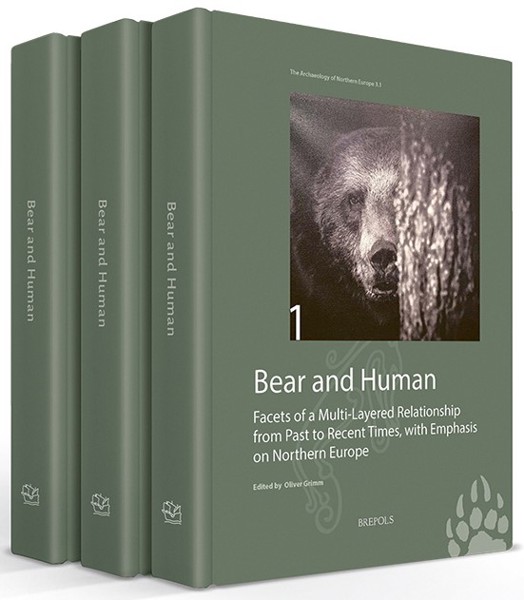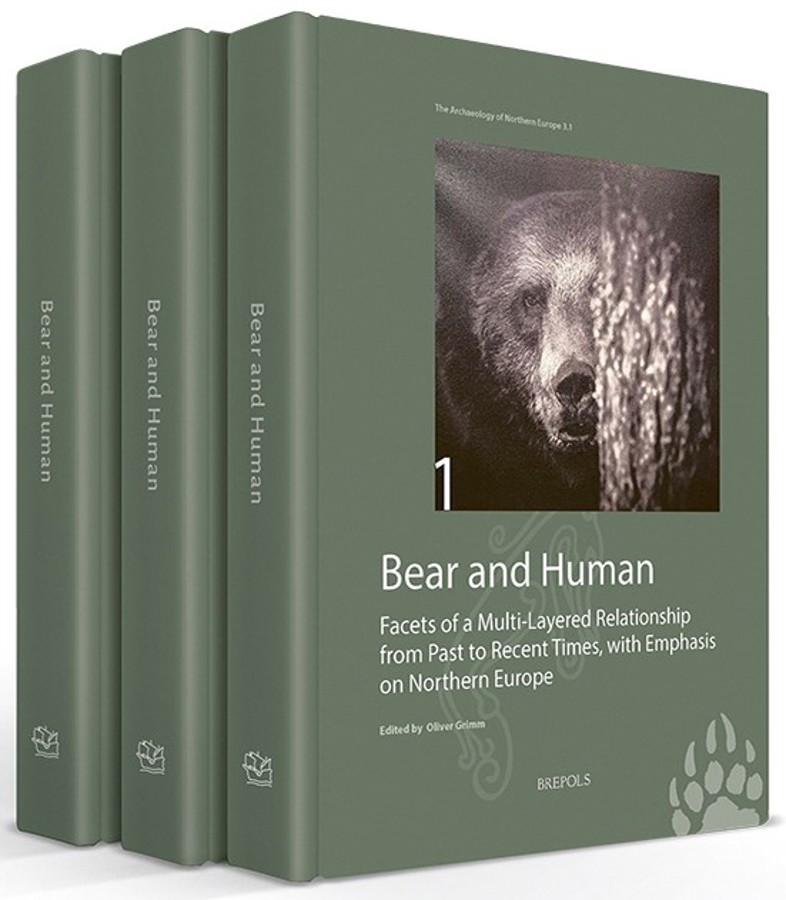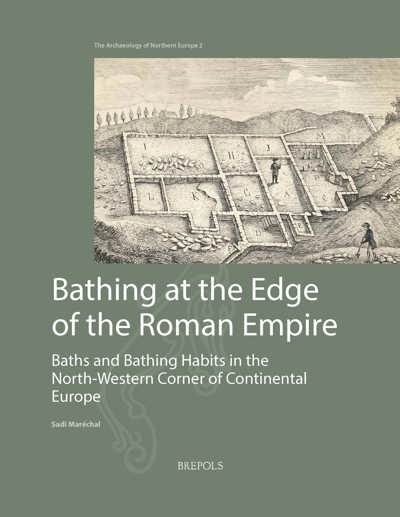
Bear and Human
Facets of a Multi-Layered Relationship from Past to Recent Times, with Emphasis on Northern Europe
Oliver Grimm (ed)
- Pages:3 vols, 1198 p.
- Size:210 x 297 mm
- Illustrations:104 b/w, 290 col., 67 tables b/w., 2 tables col., 10 maps b/w, 44 maps color
- Language(s):English
- Publication Year:2023
- € 130,00 EXCL. VAT RETAIL PRICE
- ISBN: 978-2-503-60611-8
- Hardback
- Temporarily Out of Stock
- ISBN: 978-2-503-60613-2
- E-book
- Available
A unique, interdisciplinary volume drawing together sixty-four contributions by experts from across a range of fields to shed light on the complex connections between bears and humans from the premodern into modern times, and from England to Russia.
- Archaeozoology
- Historical Sociology & Anthropology
- Cultural Studies
- Comparative & cultural studies through literature
- Northern Europe (Germania, Scandinavia, North Sea and Baltic Lands) (up to c. 500)
- Religious history (up to c. 500)
- Objects and materials (antiquities & material culture)
- History of Botany and Zoology
- Religious history (c. 500-1500)
- Religious history (c. 1501-1800)
The editor, Dr. Oliver Grimm, is senior researcher at the Centre for Baltic and Scandinavian Archaeology (ZBSA) in Schleswig, northern Germany, with a record of organizing interdisciplinary conferences and realizing extended proceedings, inter alia related to the field of Human-Animal Studies. The present book has two archaeologists (Dr. Daniel Groß, Prof. Alexandra Pesch), one biologist (Prof. Andreas Zedrosser) and one historian of religion (Prof. Olof Sundqvist) as co-editors.
Bears have, throughout human history, been admired and feared by humans in equal measure, with an interrelationship between the two species identifiable from pre-modern times through a wealth of material items, as well as from cult sites, sacral remains, images, and written sources. This unique interdisciplinary volume draws together sixty-four contributions by experts from across a range of fields in order to shed light on the complex connections between bears and humans in a period extending from the pre-modern into modern times, and across an area stretching from England into Russia. From bear biology (represented by work from the Scandinavian Brown Bear Research Project) and archaeo(zoo)logy to art history, and from history of religion to philology, the research gathered across this three-volume set explores a wide-range of subjects. Among them are the bear in biology, bears and animal agency, bear remains in graves and churches, the role of bears in religious beliefs (including berserker and bear ceremonialism), bears in literature, the philology underpinning why bear is a taboo word, and the image of the bear in rock art, as well as political iconography up to the present day. Together, these wide-ranging but closely thematic texts combine to produce a ground-breaking new work that will prove fundamental in understanding the human connection with this remarkable animal.
Book 1
List of contents
Foreword by Oliver Grimm
Chapter 1 – Bear and human: Facets of a multi-layered relationship –introduction, discussion and synthesis
“Bear and human” – introduction, discussion and synthesis
Oliver Grimm
Chapter 2 – Bears in biology (Europe)
Conservation status and distribution of the brown bear in Europe
Andreas Zedrosser and Jon E. Swenson
The history of the Scandinavian Brown Bear Research Project – a formidable success story
Jon E. Swenson and Sven Brunberg
The management of brown bears in Sweden, Norway and Finland
Michael Schneider, Andreas Zedrosser, Ilpo Kojola and Jon E. Swenson
Genetics of brown bears in northern Europe
Alexander Kopatz
Hibernation ecology of brown bears in Sweden
Andrea Friebe, Jon E. Swenson and Andreas Zedrosser
The social system of a “nonsocial” species, the brown bear
Andreas Zedrosser, Shane C. Frank, Jennifer E. Hansen, Sam M. J. G. Steyaert, J. E. Swenson
Sexually selected infanticide as a mating strategy in brown bears
Andreas Zedrosser, Sam M. J. G. Steyaert and Jon E. Swenson
Bears – fact and fiction about bear hunting and intelligence
Oliver Grimm, Andreas Zedrosser and Jon E. Swenson
Chapter 3 – Bear hunting (Europe)
Bear hunting in the later Middle Ages and early modern period, viewed from the perspective of art history and contemporary textual sources
Richard Almond
Chapter 4 – Animal agency (northern Europe)
Posthuman bears: Sight, agency, and baiting in Early Modern England
Liam Lewis
Chapter 5 – Bears in long-term archaeo(zoo)logical studies (northern Europe)
Brown bears in burials and entertainment in later prehistoric to modern Britain (c. 2400 BC – AD 1900s)
Hannah J. O’Regan
Bears and humans in Sweden – 10,000 years of interactions from the Mesolithic to the Middle Ages
Ola Magnell
Zooarchaeological brown bear (Ursus arctos) finds in eastern Fennoscandia
Kristiina Mannermaa, Tuija Kirkinen and Suvi Viranta-Kovanen
The history of the brown bear (Ursus arctos L.) in the northern German lowlands
Ulrich Schmölcke
In the company of bears: The role and significance of the bear from the perspective of the Holocene hunter-gatherer-fishers of the East European Plain forest zone (10th–3rd millennium BC)
Ekaterina A. Kashina and Anastasia A. Khramtsova
Chapter 6 – Bears in archaeo(zoo)logical, focused analysis (northern Europe)
The White One: How to frame the narrative of the world’s oldest intact polar bear skeleton, specimen S10673 from Finnoy, southwestern Norway, in a museum display
Kristin Armstrong Oma and Elna Siv Kristoffersen
The bear minimum. Reconsidering ursine remains and depictions at Pitted Ware culture (c. 3200–2300 BC) sites in Sweden
Tobias Lindström
The Kainsbakke bears and changing patterns in the human-bear relationship through the Danish Mesolithic and Neolithic
Lutz Klassen and Kristian Murphy Gregersen
Bears and the Viking Age transition in Sweden
John Ljungkvist and Karl-Johan Lindholm
Book 2
The occurrence of Ursus arctos in relation to other faunal remains in burials during the Late Iron Age (560/70–1050 CE) in Uppland, Sweden
Hannah Strehlau
Bear bones from the Viking Age cult place at Frösö church – the unifying factor in bear-human relationships in Viking Age Jämtland, northern Sweden
Ola Magnell
Bear claws in Iron Age burials on Gotland, Sweden – a first survey
Jane Jordahl, John Ljungkvist and Sabine Sten
Claws in Late Iron Age graves (c. 550–1100 CE) and bones in a castle (post 1500) – Ursus arctos in the Aland archipelago
Rudolf Gustavsson and John Ljungkvist
The power of the paw. Multi-species perspectives on the bear claw burial tradition in a long-time perspective in South Norway
Anja Mansrud
Bear skin burials revisited: Norway and Sweden, mainly Migration Period
Oliver Grimm
Sámi bear graves – results from archaeological and zooarchaeological excavations and analyses in the Swedish part of Sápmi
Elisabeth Iregren
Sámi bear graves in Norway – hidden sites and rituals
Ingrid Sommerseth
Bear bones at Saami offering sites
Marte Spangen, Anna-Kaisa Salmi, Tiina Äikäs and Markus Fjellström
Bear skin trade in the late 1st/early 2nd millennium AD – what do we know from Russian sources?
Andrei V. Zinoviev
The bear cult in medieval Novgorod, based on archaeological finds
Elena A. Tianina
Evidence of bear remains in a cremation burial in the Moscow region (Burial 5, Kremenye burial ground on the upper river Oka, 12th century)
Alexander S. Syrovatko, Natalia Svirkina and Liudmila Plekhanova
Chapter 7 – Bears in the history of religion (northern Europe)
Bears in Old Norse religion with specific references to the berserkir
Olof Sundqvist
“The Bear Ceremonial” and bear rituals among the Khanty and the Sami
Hakan Rydving
The songs and rituals of the Finno-Karelian bear hunt: Gifts, seduction and mimesis in the forest
Vesa Matteo Piludu
The Finno-Karelian bear feast and wedding: The bruin as a guest of honour of the village
Vesa Matteo Piludu
The Finno-Karelian bear skull rituals: Bringing the bruin home to ensure its regeneration
Vesa Matteo Piludu
The human-bear relationship among swidden cultivators and forest peasants in Savonia, Finland, and central Scandinavia
Marja-Liisa Keinänen
Karhurokka – traditional bear meat soup and other bear meat recipes from Finland
Tuija Kirkinen
Bear skins as a church offering
Teppo Korhonen
Bears in churches: Skins, paws, and claws from Norway
Jahn Bore Jahnsen
Book 3
Chapter 8 – Bears in literary studies and the history of ideas (northern Europe)
Bears, kennings and skaldic poetry
Maria Cristina Lombardi
The role of bears in Old Norse literature – a bestiary concept?
Agneta Ney
The bear in popular belief, legend and fairy tale
Klaus Böldl
Killer bears and bear killers in 19th-century Sweden
Karin Dirke
From monster to endangered animal: Three bear stories by Selma Lagerlöf
Claudia Lindén
Bears as pares: Some notes on bear stories in Zapinejie (Arkhangelskaya oblast, northern part of the Russian Federation) and the tendency to equality in human-bear relations
Andrey V. Tutorski
Chapter 9 – Bears in philology (northern, central and eastern Europe)
Bjornestad, Bjornbasen, and Godfardalen: Bear/human relations as referred to in place names from southwestern Norway
Inge Særheim
Germanic “bear” and Germanic personal names before c. AD 1000 with elements referring to “bear”
Robert Nedoma
The Slavic word for “bear”
Jürgen Udolph
Chapter 10 – Bears in image science (northern Europe)
Stone Age amber bear figurines from the Baltic Sea area
Daniel Groß and Peter Vang Petersen
The bear in Late Iron Age and Viking Period Scandinavian art – a survey
Sigmund Oehrl
Bears in Swedish imagery, AD 1000–2000
Asa Ahrland and Gert Magnusson
Chapter 11 – Bears in Classical Antiquity
Bear und human in Greco-Roman antiquity
Florian Hurka
Bears in Early and Middle Byzantine art (330–1204)
Martina Horn
Chapter 12 – Further reading: Bears in a broader perspective
The role of bears in the Late Bronze and Early Iron Ages in southern Germany, with a focus on the Hallstatt period
Melanie Augstein
Tracking former royal dignity: The bear in medieval German literature
Sabine Obermaier
“The Bear’s Son Tale”: Traces of an ursine genealogy and bear ceremonialism in a pan-European oral tradition
Roslyn M. Frank
The bear in European folktales – with a special focus on Scandinavian variants
Angelika Hirsch
The role of the bear in the Russian folk tale: Personage, plot type, and behavioural scenarios
Inna Veselova
Bears bring spring: An anthropological view on the role of the bear in middle European winter feasts
Jet Bakels and Anne Marie Boer
What are those bears doing there? On a painting from early Italian art
Henk van Os
Bear-human interactions: Archaeological and ethnographic investigations in North American indigenous cultures
Kerry Hull
Bears in the starry sky
Ernst Künzl




